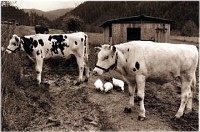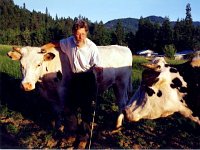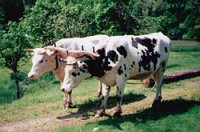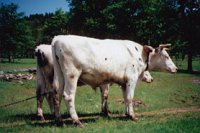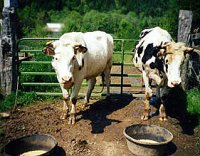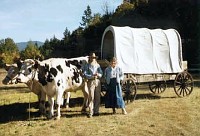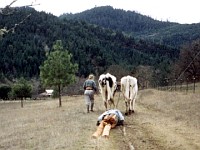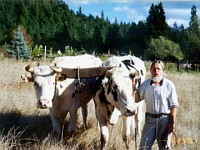~~*The Oxen at Singing Falls*~~
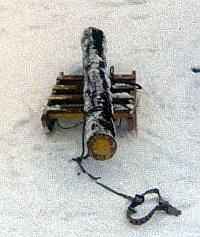
Human traction
In 1981 we were in the process of transitioning from “back to the land” experimentation in Colorado to the “them that's doing” mode in the hinter lands off the grid in Northern Montana. It was an exciting and challenging period of time for us. The plan was to abandon ourselves to the wilds and survive on a shoe string. There were just enough resources to purchase the property right out or to place a substantial down payment and make payments for twenty years with the extra weight of interest added onto it.
Our “do or die ” attitude demanded we go with the first option. The venture before us demanded we be unconventional and sacrificial. How were we to build with nothing and feed the bankers also? The entire nest egg went into the land purchase. Everything was to be done with the resources at hand or not accomplished at all.
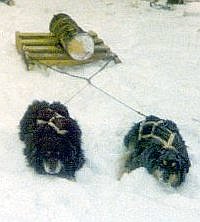
Canine traction
Over the years in Colorado we had been building up our hand tool inventory. That was a stroke of wisdom, it turns out. I've made good use of all of them at one time or another. The one thing we did not make provision for was our farm traction needs. We decided that our small pickup would have to suffice in that regard. It was a new 4x4 with a good sturdy winch mounted on the front bumper. For some tasks it was fantastic. Most especially long distance hauling. But when it came to actual on the ground on the homestead transport jobs it had its limitations. There was a considerable degree of log skidding done by a harness belt attached to my shoulder. Many of the short 12 foot 8-16 in. diameter logs that we used for the construction of our short log timberframe home were extracted using this method. Basically we did everything the hard way.
Oregon for Halutzim
Fast forward to 1991 and South Western Oregon where we are today (2008 at the time of this writing). We knew upon our arrival to Singing Falls that we were starting over again – at age forty plus years for both of us. I had determined that my days of manual log skidding and hand tool gardening were over (they're not :) ). Shortly after the acquisition of the property we invested in a 1950's vintage Massey Ferguson tractor. It had a front end bucket with fork tines and looked pretty. Click here to see the wicked thing for your self.
[rant] I must state here and now that I despise what I call the “infernal combustion engine”. Of all the tasks I have performed as an “owner builder” self reliant individual, working on vehicles was the least rewarding to me. Even the older vintage machines that were less prone to planned obsolescence often frustrated me. I've rebuilt several engines and a transmission just for the record. But it is the proprietary format of parts and tools that irked me the most. They're dirty. They stink. They're noisy and they... :) [/rant]
The conscious design of "lock-in" and making of minimal quality parts for the after market are only a fragment of the problem. Tools are expensive and often specialized. The cost of running vehicles, insuring them, registering them, repairing them and living with them individually and collectively as a society is incalculable. I absolutely abhor road kill. It is the darkest and most blatant testimony against these unnatural monsters and the system needed to support them. Nevertheless, I buckled under and have done the work of vehicle maintenance carefully and successfully myself. (There's nothing like having an engine and parts laying around the living room floor in already cramped quarters).
What, you say, would compel a person with that type of disposition toward vehicles to purchase a tractor? The short answer to that is pain. Pain in my back to be specific. I could see that the strength spent in my youth was slightly on the wane. Nothing really chronic mind you. Just the occasional bout of complete incapacitation. We were now stewards of more acres and there really wasn't any other option that I could think of to tackle the formidable work load that lie ahead.
After some minor repairs on the tractor made by the previous owner arrival day came. He showed up on time and pulled into my neighbors 'out way' along the road. On to the tractor I hopped beaming like a new father. Ignition on and in reverse I went. As I backed out off the ramp and touched down on terra firma one of the huge rear wheel tires blew with a blast, leaking calcium chloride all over the ground. “Take it back!” So the previous owner in collusion with the tire company put on a new tire. “Fair 'nough”, I thought.
It wasn't long after that, that the main hydraulic unit failed without any provocation on my part I can assure you. I should have known. I should have. Off that metal beast was going to go. Perhaps to a person who delights in the notion of repairing such contraptions. For my part I was left with the ugly task of applying my dwindling brute force for the jobs needing doing, considerably poorer and a tad wiser.
In the interim time passed and the development of our new place of sojourn progressed well. The new herd of angora goats and the small flock of sheep were coming along fine. The greater expanse the new acreage afforded us was a welcome asset.
After due consideration we gingerly ventured into the realm of larger livestock species to see if could integrate them into our operation. In particular the bovine was of interest to us. With the tender nurturing of my spouse we were able to successfully rear several steers for our organic meat supply and bring to maturity a wonderful milk cow. (Alexandra should have been a veterinarian.) What made the venture unique was the fact that these were auction cattle called “day olds” which, for various reasons, have a very poor survival rate. Basically they are the result of dairies freshening their production cows for milking. Some dairies cross breed with meat breeds to enhance saleability at auctions. Others have told us from experience that the success rate of rearing these poor creatures was very slim. Hence their relatively low cost. A fairly healthy day old bull calf went for $85.00 - $100 dollars each. My wife was generally able to pull them through with TLC and herbal treatments. Really, she is quite good at it. In spite of our successes living in the inhospitable climes of the Colorado Rocky High Country and off the grid in the hinterlands of northern Montana; we were still considered “Hollywood Farmers” by the local elders and old timers. It was Alexandra's skills as an herbalist, nurturing calves to health that won the village over.
The good wife had been published in the “Small Farmer's Journal”. While perusing the personal ads one day, I came across the name of Frank West. He lived in Rogue, Oregon which is just over the mountain from us. The pamphlet he was selling pertained to training oxen. It was titled, “Manual for training steer for oxen”. My mind and eyes lit up. A visit was arranged and we were on our way.
Mr. West at the time was 91 years old and blind. The visit lasted from morning until evening with much talk about ox training and animal traction. A better part of the conversation concerned our spiritual beliefs, the most of which we held in common. This tried and true elder was wizened by the years and very much spiritually alive. “Mr. West,” I said, “would you lay your hands on me and ask the Lord to bless me with your skills of training and handling oxen? Perhaps He will place your mantel on me.” In that solemn moment I knew that oxen would be in our lives. The day ended with pamphlet in hand and a resolve to train a pair of steers. My regard for the late Mr. West is very high. He is in a much happier place now.
Singing Falls was well prepared for a couple of newcomers. There was the old barn for shelter and Camille the Short Horn/Jersey cross for the milk we would be needing. Our reluctance to experiment with adding large livestock to our system of living had passed. We found cattle to be intelligent and friendly. And also, not to be offensive or arrogant, if the effort to integrate animal traction into our way of life failed we always had the option to gain organic beef for our sustenance. It would not be a total loss.
The day for the Country Auction had arrived. Off we went prepared to come home with our wanna be oxen. The sale was packed as usual with cow pokes from the SW corner of the State. By now we knew quite a few of them and they had an idea of what we were up to. We left with a couple of strapping Holstein day old bull calves.
There was a bit of a tuck with one of the calves. Bright was his given name and the transition to Singing Falls was just too much for him. He was down with pneumonia and a touch of enteritis. Immediately he was off his milk ration and on a regime of electrolytes and herbs.
Every two hours, night and day, he was getting liquids and herbs. Yarrow to take care of the fever. Slippery elm to soothe his digestive tract. Garlic juice as an antibiotic. To the herbal concoction she would add the electrolytes. It worked well and his fever finally broke. (Have we ever used commercial antibiotics in our efforts to keep calves alive? Yes.)
They were halter trained right from the start. At first they didn't like it and resisted considerably. My tact was to associate the harness with their milk feedings. Soon they were practically jumping into those halters. Early on I trained them to stay at bay until I gave them the command to “come!” when feeding time arrived. The last thing I needed was two 2000 lb steers trampling me at chore time. They kept these habits all their days.
Once they were confident in us I began the training sessions. Mr. West was an advocate of instructing the steers separately out of ear shot of one another until they individually knew the commands. Once that was done they reinforced one another each time a command was given.
And so it began. The “BOYS” and I bonded into a wonderful relationship. Soon “gee”, “haw”, “back”, “gidup” and “whoa” could be heard ringing in the fields and hills of Singing Falls. Of course a steer is not an ox until he's four years of age. It's not until then that their green skeleton is capable of handling a full load. Their muscles can manage tasks at an early age but the young frame must harden into maturity before it can be used without damage. To be sure, they can be used for light work when young. At that stage they are classically called “handy steers”. And work they did for many years.
When the team was fully mature they were ready for any task that we had here at Singing Falls. It mattered not if bales of woven wire sheep fencing needed to go up the mountain side or if 16 foot long 10 X 10 beams were being extracted from the back forty forest; the job was a breeze and enjoyable for Bright and Tears. Their strength was remarkable to say the least. They skid all of my timberframe barn beams without the slightest hesitation and no doubt I never utilized their full potential.
Would I recommend oxen over tractors or horses today? Without hesitation the answer is yes. If you were to ask the reasons why, I think this short list would cover some of the response.
1. Cattle are warm and friendly MOST of the time. (Subject to change with the weather) This will depend of course on the disposition of the breed of choice. Proper training is a significant factor also. Any thing can be spoiled. This is in stark contrast to a machine and its cold unresponsiveness.
2. Oxen grow their own fuel supply, converting sunlight and co2 into a nutritious feed from the field.
3. They are capable of growing the fuel supply of their drover and family along with many other creatures on the homestead.
4. Their exhaust is a most excellent fertilizer. The well broken down vegetable matter of steer manure has a good quality phosphorous content also. It is unsurpassed for the organic garden or for replenishing the hay field.
5. Oxen operate on voice command, body language, or both. That's high tech in my book.
6. Functional operation equipment is easily hand made or inexpensively purchased. A good yoke is not difficult to make and bent 1 ½ steel pipe makes an excellent bow where hickory wood is not available. Strong rings and chains are available in most hardware or saw shops.
7. They are able to maneuver on slopes and terrain not hospitable to mechanized equipment. Bright and Tears hauled materials for me to places on a mountain side that few humans would walk in these days.
8. Given a little care, any wounds they have will heal themselves. Try that with a flat tire or busted hydraulic valve.
9. There are triple purpose breeds whose cows perform quite well as meat, milk and work providers. These have some limitations but the benefits far outweigh the drawbacks.
10. One of the most valuable benefits of working with oxen is the privilege of working and interacting with a living creature whose loyalty, friendship and service is a willing gift when treated and trained properly. They really do enjoy working and interacting with humans.
11. By design, nature produces the best quality product it can make with the materials it is given. This is in contrast to the marketing schemes of modern industry. I'm not against marketing. Only the sale of modern devices to get rich quick.
12. Oxen do not require the expensive equipment, tack or high end foods that a horse requires. They are hardy and are able to endure exposure to the elements of nature.
So there you have it. I guess the most appealing aspect of using animal traction is the fact that it is by far MORE sustainable and self reliant than the use of heavy equipment on the farm.
The bovine suffers from the same vulnerabilities as humans to disease and accidents. And they require care in most cases even when they are not in use. For oxen in particular that care is minimal given enough good pasture. Some breeds lend themselves more to “free range” than others. Knowing your land and its proclivities goes a long way in understanding what the needs of your oxen will be in any given season. Understanding what parasites and mineral deficiencies are in your area will be essential facts to know in order to keep your team healthy and happy. Even with a watchful eye the unexpected can happen. In his later days Bright the off ox seemed off in health.
After his untimely accidental demise I did an internal exam and found a large wad of poly rope in his first stomach. By the looks of it, it had been there for years without causing too much of a problem.
Oxen are not fast but long legged breeds will give you a work out. Rarely will you find road kill in an oxen's path. On the other hand, the pace of work is a natural one suited for man and beast alike.
And finally, I would be dishonest to suggest that there wasn't another big drawback. When you're done with your tractor for the season you park it and turn off the key. No real bother until it is needed again (except the ever rising multilevel costs of petroleum based fuels and worn out parts). When it becomes simply unrepairable you can haul it off to the scrap yard. When Bright and Tears passed on in their respective times it broke my heart. The living friendship between us still bears its mark on my soul. I won't ascribe it to old age sentimentality. My friends, Bright and Tears are gone. What they have added to my life remains a rich legacy.
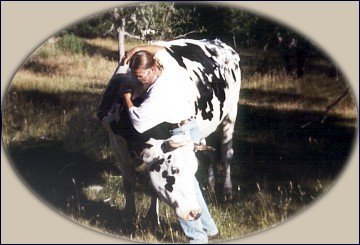
Tears gives me a hug.
TOP




